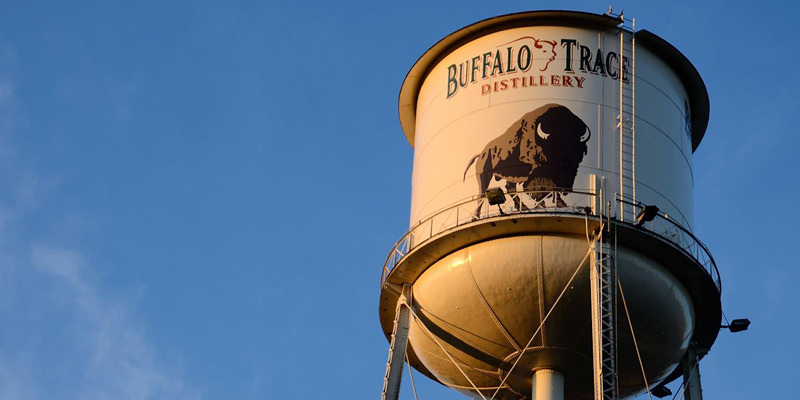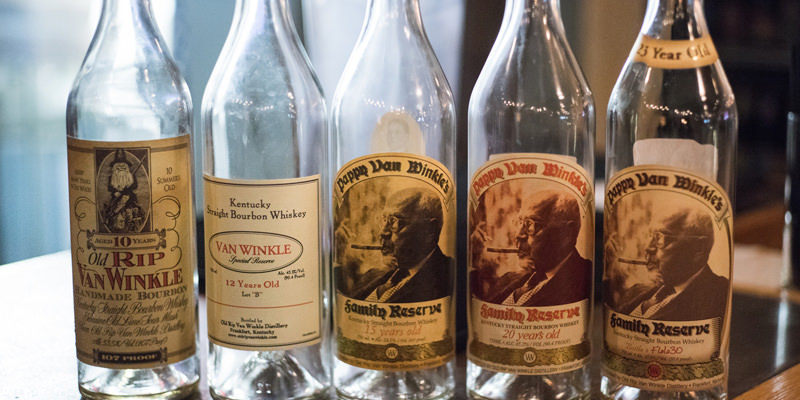Not asking the way Jerry Seinfeld asks what’s the deal with airport peanuts (actually…does he ever do that?). Asking in the way people fairly interested in bourbon, semi-versed in distilling history, and completely out-priced to enter the annual mosh pit Pappy craze, might ask: with a bit of terror, a bit of annoyance, and just a dash of outsider envy.
Nor are we the first to ask. In fact, like huddled cowards waiting for brisket dregs at a wedding buffet, we come late and come last, after Pappy Van Winkle has become so ubiquitous that Jim Beam-swilling college students probably got the Pappy reference in that two-hour Google ad (a movie called “The Internship,” and shame on you Vince Vaughn). Like the thousands upon thousands of people on Pappy waiting lists, we realize we have no chance of getting the storied bourbon. And even if we could, there’s also the fact that buying a bottle of Pappy Van Winkle 20-year might be the cost of a minor surgery. Question is—just why is this bourbon so very special, so very freaked out about, and so very, very expensive?
Short answer: because it’s almost entirely unique. Long answer: because hype drives price. Just like a painting sold at auction for millions, the value of a thing can pretty rapidly become subjective.
So why did the value of Pappy Van Winkle (specifically the 15-, 20-, and 23-year) get so weirdly subjective in the past ten or so years? That’s kind of a long story, but it’s one worth telling, if not necessarily weeping over or threatening violence for. (See below.)
First, yes, there was a dude named Pappy. And he was eccentrically deserving of that nickname. Julian Proctor Van Winkle Sr., the man who’d become “Pappy,” started as a salesman for W. L. Weller in 1893. He rode a horse and buggy, and sold stuff that wasn’t nearly up to bourbon quality standards—bourbon that had been “rectified,” or “fixed” with various additions (including straight-up nasty grain alcohol). Later in life he wore a Panama hat, used an unnecessary cane for flourish, and ate a bun-less hot dog and onion sandwich every day for lunch. So that’s kind of fun.
As for how Pappy Van Winkle the bourbon came to be? We’ll do our best MicroMachines download. Pappy and fellow W.L. Weller employee Alex Farnsley eventually bought Weller, and later joined forces with nearby Arthur Philip Stitzel distillery. They’d both survived Prohibition, like our friend Chuck Walgreen, by distilling “medicinal” whiskey. But once prohibition was over, they joined forces (Weller had been outsourcing some of its distilling to Stitzel for a while already). They opened up as Stitzel-Weller in 1935. And they needed to put out a whiskey fast.
Stitzel-Weller went with a wheated bourbon recipe. Most (proper) bourbon at the time was made with at least 51% corn, plus barley and rye. The use of wheat would yield a smoother, slightly sweeter bourbon—and could, theoretically (and ironically, given the Pappy story, again, see below), be put out to a Prohibition-parched market sooner.
So, Stitzel-Weller put out a young(ish) wheated bourbon legally. Great. Things might have continued on just fine—and far more quietly—for the Van Winkle clan, but for some fateful adversity. One: being forced out of Stitzel-Weller in 1972. Julian Jr. had to sell the family’s stake in all but the Old Rip Van Winkle name, keeping some of their bourbon and bottling it as, well, Old Rip Van Winkle. Two: the ‘70s. Yeah, bummer for all, especially anyone who’s got a photo of themselves in tight white bellbottoms tucked away somewhere. But for the Van Winkles, the ‘70s meant a huge decline in bourbon sales. People wanted big hair, John Travolta, and vodka (also gin and aged Scotch). In fact, Julian III had to “resort” to some serious kitsch—putting their 7 year-old Old Rip Van Winkle bourbon into cartoonish ceramic decanters—coal miners and Leprechauns. (Those decanters, heads up, are highly sought after today, ideally full—though the bourbon inside can have dangerous amounts of leached lead).
Julian III did his best to keep the family business alive through the 80s, even opening his own bottling plant (prone to flooding, more bad luck). Running out of ideas, and with loads of his wheated bourbon just aging “uselessly” in barrels around Kentucky, Julian III got an idea: sell it old. Sell it real old. And this is what really distinguishes (and justifies the mile-high prices?) of Pappy. Most bourbon at the time wasn’t sold much older than 12 years. By the 1990s, Van Winkle had bourbon that had spent an unprecedented 15, 20, and 23 years in the barrel. An entirely unique category was born: ultra-aged wheated bourbon, bottled under the label (here it comes!) “Pappy Van Winkle Family Reserve.” Happy ending? Not quite. Nobody cared. Yet.
But starting in 1996, everything changed. A Chicago sales rep submitted a bottle of the 20-year Pappy Van Winkle Family Reserve to that year’s Beverage Tasting Institute’s annual competition. It scored an unprecedented 99 out of 100. Other factors aligned like a charred new-oak barrel-shaped constellation, including the beginning of the craft cocktail renaissance, and America’s now decades-long love affair with its own whiskey.
By the time the 2000s hit, Pappy Van Winkle had cachet among bourbon insiders. By the 2010s, it was being hunted by casual bourbonites and even plain old collectors of anything exotic or expensive. The stuff’s released annually, in 35 states and the UK, with the release day in any location ceremoniously known as “Pappy Day.” And while there are suggested retail prices, topping out at around $250 for the 23-year, what you’ll pay can vary drastically, especially if you’re buying online. As for what it tastes like, does that matter at this point? Will people actually open the bottles?

Many will, yes, and with good reason. We’ve heard (sigh) it’s incredibly smooth, sweet with notes of caramel, vanilla, and citrus fruit. Some bourbon writers prefer the 15, which has a little bit more lingering bite, some swear by the 20 as the happy medium, and, for some, the 23 year is less something to drink than worship (and vice versa). Stitzel-Weller shuttered in 1992, but in 2002 Buffalo Trace struck up an agreement with the Van Winkles. So “Pappy” is being distilled (though more importantly, aged low and slow in the rickhouse) once more in Kentucky. But then, so is a lot of other great bourbon.
“PAPPY VAN TRIVIA” TO WOW YOUR FRIENDS
- At the entrance of Stitzel-Weller there was a plaque with the Van Winkle motto: “At a profit if we can, at a loss if we must, but always fine bourbon.”
- Speaking of loss, to make 3 gallons of 23-year Pappy, 50 gallons of bourbon are actually lost to the angel’s share (evaporation over time)
- “Pappy Day” is not a happy day, for liquor retailers at least. According to Julian III and some angry liquor store owners, people cry, scream, threaten with shoes and firearms. Some stores (even states) elected to opt out of receiving any Pappy at all.
- Despite the failure of firearms to intimidate, one Pappy seeker used cupcakes as a bribe—and it worked.
- There was a Pappy heist—65 cases, about $25,000, stolen from the Buffalo Trace distillery in 2013; about 20 have been recovered, and were going to be auctioned for charity, but Julian III (rightfully, tragically, villainously) asked they be destroyed—they might have been tampered with.
- Stitzel-Weller vs. Buffalo Trace: This is more for bourbon aficionados and collectors, but basically, as we said, the bourbon in Pappy might have been distilled at a small number of places (the 20 year that got 99 out of 100 from the Beverage Tasting Institute was probably purchased from Wild Turkey and distilled at Old Boone). But the major divide is Stitzel-Weller, who stopped distilling Pappy Van Winkle in 1992, and Buffalo Trace, who took up distilling for the Van Winkles in 2002. Meaning, potentially, the last release of Stitzel-Weller 23 Year-Old Pappy Van Winkle was in 2015.
- Despite popularity to rival Bieber Fever, the Van Winkles have no desire to expand operations. In their new partnership with Buffalo Trace, they’ll increase production 2 to 3% per year. They put out about 8,000 barrels a year, compared to the millions put out by other bourbon producers.
- Julian III and his son Preston now run Old Rip Van Winkle, and they get phone calls and letters, seriously tragic stories and accompany pleas for Pappy. (Also someone pretending to be Steve Martin’s assistant; he wasn’t.) That won’t get you a bottle.
- You can’t get Pappy, you can get Pappy swag. The Van Winkle daughters have created a Pappy lifestyle brand shop, meaning you can get a bowtie, or a needlepoint dog collar, and lots of other stuff to show your love of Pappy.

